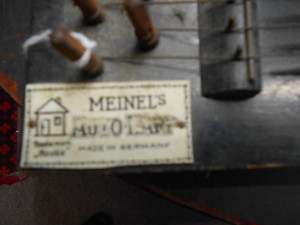Hungerford Arcade stallholder, Don Greenslade, came across this beautiful Lyre/Zitter on his travels and just had to buy it. This one is German, made by Meinel's. Here is a short history of the instrument.
 Lyre from various times and places are regarded by some organologists as a branch of the zither family, a general category that includes not only zithers, but many different stringed instruments, such as lutes guitars, kantele and psalteries.
Lyre from various times and places are regarded by some organologists as a branch of the zither family, a general category that includes not only zithers, but many different stringed instruments, such as lutes guitars, kantele and psalteries.
Others view the lyre and zither as being two separate classes. Those specialists maintain that the zither is distinguished by strings spread across all or most of its soundboard, or the top surface of its  sound chest, also called soundbox or resonator, as opposed to the lyre, whose strings emanate from a more or less common point off the soundboard, such as a tailpiece. Examples of that difference include a piano (a keyed zither) and a violin (referred to by some as a species of finger board lyre). Some specialists even argue that instruments such as the violin and guitar belong to a class apart from the lyre because they have
sound chest, also called soundbox or resonator, as opposed to the lyre, whose strings emanate from a more or less common point off the soundboard, such as a tailpiece. Examples of that difference include a piano (a keyed zither) and a violin (referred to by some as a species of finger board lyre). Some specialists even argue that instruments such as the violin and guitar belong to a class apart from the lyre because they have  no yokes or uprights surmounting their resonators as "true" lyres have. This group they usually refer to as the lute class, after the instrument of that name, and include within it the guitar, the violin, the banjo, and similar stringed instruments with fingerboards. Those who differ with that opinion counter by calling the lute, violin, guitar, banjo, and other such instruments "independent fingerboard lyres," as opposed to simply "fingerboard lyres" such as the Welsh crwth, which have both fingerboards and frameworks above their resonators.
no yokes or uprights surmounting their resonators as "true" lyres have. This group they usually refer to as the lute class, after the instrument of that name, and include within it the guitar, the violin, the banjo, and similar stringed instruments with fingerboards. Those who differ with that opinion counter by calling the lute, violin, guitar, banjo, and other such instruments "independent fingerboard lyres," as opposed to simply "fingerboard lyres" such as the Welsh crwth, which have both fingerboards and frameworks above their resonators.
For all the latest news, go to our new website at www.hungerfordrcade.com


 Lyre from various times and places are regarded by some organologists as a branch of the zither family, a general category that includes not only zithers, but many different stringed instruments, such as lutes guitars, kantele and psalteries.
Lyre from various times and places are regarded by some organologists as a branch of the zither family, a general category that includes not only zithers, but many different stringed instruments, such as lutes guitars, kantele and psalteries.

No comments:
Post a Comment